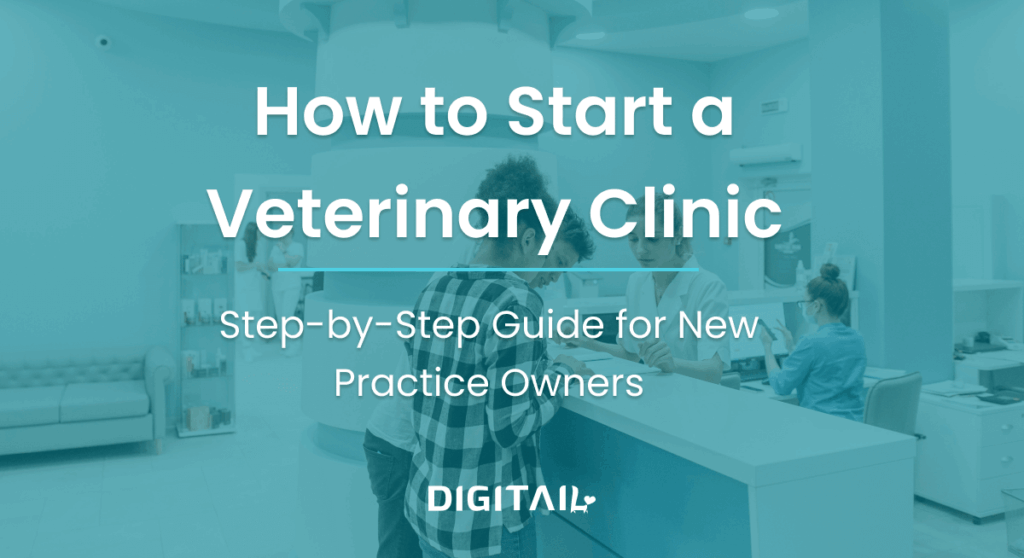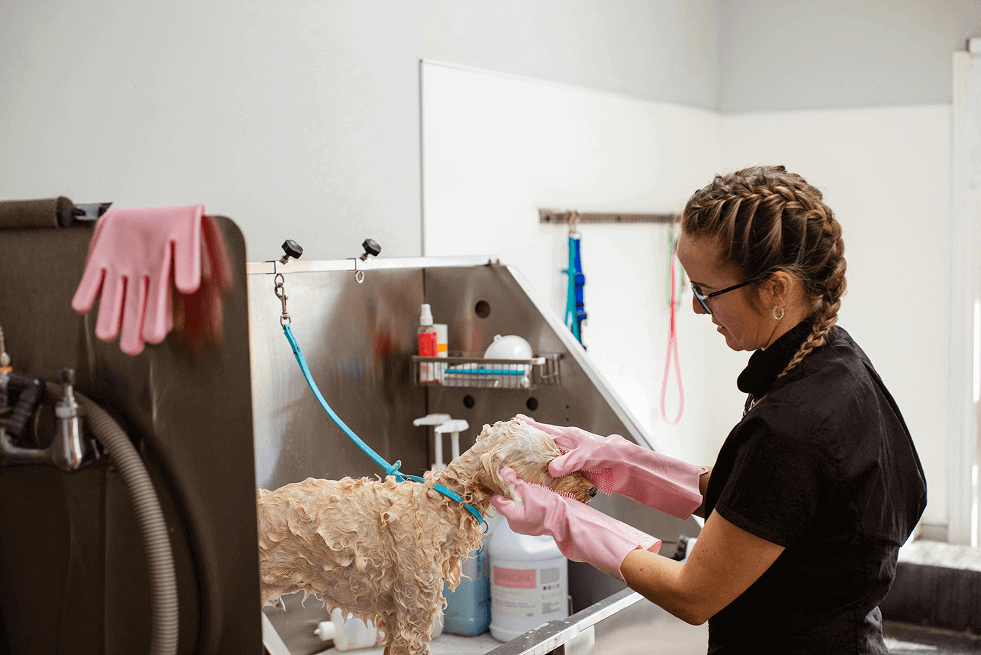- Artificial Intelligence
- Pet Care
- Team & Client Retention
- Veterinary Business
- Veterinary Practice Management

How to Start a Veterinary Clinic: Step-by-Step Guide for New Practice Owners
Opening a veterinary clinic is more than a career move — it’s an entrepreneurial leap into one of the most resilient industries in healthcare. Pet ownership continues to rise, with 71% of U.S. households — more than 94 million homes — now owning a pet, and veterinary services are expected to grow at a compound annual rate of 8.7% through 2030. That steady demand makes veterinary practices not just fulfilling, but also profitable businesses with EBITDA margins averaging 15–20% in well-run clinics.
But starting a veterinary clinic is more than just following your passion for animal care — it’s about building a sustainable, profitable business in one of the most recession-resistant industries in healthcare. It takes capital, business acumen, smart strategy, and an understanding of modern veterinary trends.
This guide isn’t meant to answer every question but to serve as your roadmap for what to expect and where to focus first. Think of it as a blueprint: the big-picture steps you’ll need to take, plus the critical business factors to watch. Once you understand these essentials, you’ll be better equipped to dive deeper into each area with advisors, tools, and partners.
1. Foundation for a Successful Veterinary Clinic
Every successful veterinary startup begins with clarity of vision. What kind of veterinary practice do you want to create? Are you planning:
- A general practice focused on neighborhood families?
- A boutique clinic specializing in exotics?
- A mobile practice that brings care directly to clients’ homes?
Your choice defines everything else: location, investment level, pricing strategy, and team structure.
But vision alone isn’t enough. Running a profitable clinic demands far more than clinical expertise. It requires financial acumen, operational leadership, marketing savvy, and the resilience to adapt when challenges inevitably arise. Reflect honestly on your skills and experience. If finance, HR, or marketing aren’t your strengths, consider mentors, advisors, or even formal training that can fill those gaps.
2. How to Do Market Research for a Veterinary Clinic
Market research is your foundation for making data-driven decisions about location, services, pricing, and competitive positioning. This isn’t just about confirming demand — it’s about quantifying revenue opportunity and identifying your path to market leadership.
Start by analyzing the demographics of your target market.
- How many active pet-owning households are in your area?
- What species are most common?
- What’s the average household income, and how does that correlate with pet spending patterns?
Study the competitive landscape not to copy existing practices, but to identify underserved market segments and service gaps. Are there opportunities in emergency care, specialized surgery, or dental services?
By validating demand and identifying service gaps, you position your clinic not just as “another vet,” but as a business designed to capture unmet market potential.
3. How to Write a Veterinary Business Plan
Your business plan isn’t just a document to get financing (though it’s essential for that too) – it’s your strategic roadmap for building a profitable practice. But here’s where most plans fall short: they focus too much on clinical services and not enough on the business systems that actually drive success.
Start with your competitive positioning. What makes your clinic different, and why should pet owners choose you over established competitors? Perhaps it’s your commitment to fear-free handling, your investment in cutting-edge diagnostics, or your focus on client education and digital engagement.
Next, map out your milestones. When do you hope to open your doors? What are the key steps along the way: securing financing, signing a lease, hiring your first team members, launching your website? Assign deadlines and hold yourself accountable.
Financial planning is where many new clinic owners stumble. They underestimate costs and overestimate how quickly revenue will ramp up. Be brutally realistic about your startup investment:
Starting a veterinary clinic often requires $800K–$1.5M. Major costs include:
- Facility buildout or renovation
- Medical & lab equipment
- Technology & software
- Initial inventory & supplies
- Payroll & insurance
- Marketing
Project your revenue and expenses for at least the first three years, and include a buffer for the inevitable surprises. Lenders and investors will expect to see detailed, data-driven forecasts, so don’t cut corners here.
Your business plan should also detail your marketing strategy. How will you attract your first 500 clients? Digital marketing is non-negotiable: 70% of pet owners research veterinarians online before making appointments. Plan for SEO-optimized websites, Google Ads, social media presence, and online review management.
Finally, include a risk assessment. What could go wrong, and how will you respond? A thoughtful, proactive approach to risk management will set you apart as a serious, prepared owner.
4. How to Define Veterinary Services & Pricing
Define the core services that will drive your clinic’s profitability. Your service mix directly impacts both revenue potential and operational complexity. Will you focus on high-volume preventive care, specialized diagnostics, surgical procedures, or a comprehensive mix?
High-Margin Service Categories:
- Preventive care and wellness plans (40-60% gross margins)
- In-house diagnostics and laboratory services (50-70% margins)
- Surgical procedures and dental care (60-80% margins)
- Specialty services like exotic animal care or behavior consulting
Each service category requires specific equipment investments, staff training, and compliance requirements. Emergency care can generate $2-4 million annually but requires 24/7 staffing and specialized equipment. Specialty services often command premium pricing but serve smaller market segments.
Consider revenue diversification beyond core medical services. Successful practices often include:
- Retail products (food, supplements, accessories) with 30-50% markups
- Boarding and grooming services for recurring revenue
- Telemedicine consultations combine low costs with premium pricing
- Wellness membership programs for a predictable monthly income

Pricing is both an art and a science. Many clinics use a combination of cost-plus (calculating all expenses and adding a margin), competition-based, and value-based pricing:
Step 1: Start by researching what local competitors charge, but don’t simply undercut them.
Step 2: Consider your costs and the value you provide.
Step 3: Evaluate what your target clients are willing to pay.
Be transparent with clients about your fees, and use your practice management software to ensure every service is billed accurately – missed charges are a silent profit killer.
5. How to Choose the Best Location & Facility for a Veterinary Clinic
Location impacts everything: your client demographics, competition level, operating costs, and growth potential. This isn’t a decision you can easily change later, so get it right from the start.
Look beyond just foot traffic or rent costs. Analyze the demographics within a 5-10 mile radius: pet ownership rates, household income levels, population growth trends, and lifestyle factors. Areas with young families, affluent retirees, or growing suburban communities often provide ideal client bases.
Strategic Location Factors:
- Proximity to residential neighborhoods with high pet ownership.
- Visibility and accessibility from major roads. Don’t forget about parking, signage, and compliance with local zoning and health regulations.
- Adequate parking and easy pet transport access.
- Complement to pet-friendly businesses (stores, parks, groomers) that can drive foot traffic and referrals.
- Evaluate the physical space with an eye toward both current needs and future growth. Is there space for surgery, imaging, kennels, and staff areas? Can the layout support efficient workflows and a welcoming client experience?
Decide whether to lease or buy, and whether to build from scratch or renovate an existing space. Each option has pros and cons, from upfront costs to long-term flexibility.
Your facility layout directly impacts operational efficiency, client experience, and your team’s daily workflow. Poor design decisions can handicap your practice for years.
Essential Spaces:
- Reception and waiting areas
- Adequate exam rooms with efficient workflow design
- Surgical suite
- Laboratory and imaging areas for in-house diagnostics
- Pharmacy and treatment areas
- Staff spaces for breaks and administrative work
- Storage for inventory and supplies

Consult with a veterinary architect early. They’ll help you avoid costly mistakes and design a clinic that supports both patient care and staff well-being.
6. Veterinary Clinic Startup Costs & Financing Options
Undercapitalization kills more veterinary startups than any other single factor. Understanding your true funding needs and having access to appropriate financing are critical for success.
Starting a veterinary clinic typically ranges from $800,000 to $1.5 million, depending on your location, size, and service scope.
Most new clinics are financed through a combination of personal savings, bank loans, and sometimes private investors.
Small Business Administration (SBA) loans are a popular option, offering favorable terms and lower down payments for qualified borrowers. To secure financing, you’ll need a detailed business plan, three years of financial projections, and a strong personal credit history. Lenders will look for evidence that you understand the veterinary business, have a clear growth strategy, and are prepared for the realities of practice ownership.
Be conservative in your projections and build in a buffer for unexpected expenses. It’s better to be pleasantly surprised than caught short. And remember, your largest ongoing expense will be payroll. Invest in your team, and your business will reap the rewards.
7. How to Build Your Veterinary Project Team
Successful practice ownership isn’t a solo journey. Surround yourself with professionals who understand the veterinary industry and can guide you through the complex startup process.
Essential Team Members:
- Banking Partner
Choose lenders experienced in veterinary practice financing. They understand industry cash flow patterns and can structure loans appropriately for your business cycle. - Practice Management Consultant
Industry specialists provide invaluable guidance on workflow design, equipment selection, and operational efficiency. The investment typically pays for itself through avoided mistakes and optimized systems. - Veterinary Architect
Don’t underestimate specialized architectural expertise. Veterinary-specific architects understand unique requirements like HVAC for animal environments, soundproofing, workflow optimization, and regulatory compliance. - Industry-Focused Accountant
CPAs who specialize in veterinary practices provide essential services including business structure optimization, tax planning, financial reporting systems, and benchmarking against industry standards. - Business Attorney
Legal counsel experienced with veterinary practices helps navigate licensing, contracts, employment law, and regulatory compliance specific to animal healthcare.
Don’t underestimate the value of peer support. Talk to established practice owners about their experiences — their insights can save you time, money, and headaches. Remember, you can always scale up, but it’s much harder to scale down. Start with a solid foundation, and build from there.
8. Legal Requirements & Licensing for a Veterinary Clinic
Getting your legal and administrative foundation right from the start prevents costly problems later. While this isn’t the most exciting part of starting your practice, it’s absolutely essential.
Begin by forming your legal entity — LLC, corporation, or partnership — based on your goals and risk tolerance. Register your business with state and local authorities, and secure all necessary licenses and permits. This may include veterinary board certification, sales tax collection, etc.
Choose a business name that reflects your brand and isn’t already in use. Secure your domain name and set up a professional website — your digital presence is as important as your physical one. Register for an Employer Identification Number (EIN) and set up dedicated business banking and credit accounts to keep your finances clean and organized.
Invest in comprehensive insurance coverage, including general liability, professional liability, and workers’ compensation. Consult with legal and financial advisors to ensure you’re fully protected and compliant with all regulations.
9. Veterinary Clinic Equipment & Software Essentials
Modern veterinary practices are increasingly technology-driven, and your choices here will impact operations, efficiency, and competitive positioning for years to come. The right technology stack becomes your practice’s operational backbone, connecting every aspect of your business from scheduling to medical records to client communication.
Choose hardware that supports your workflow — computers, tablets, diagnostic equipment, printers, and label machines. Invest in digital radiography, ultrasound, and in-house lab equipment as your services require. Set up secure, cloud-based storage for medical records and ensure your systems are compliant with data privacy regulations.

Once the foundation is in place, it’s time to think about how all these moving parts connect. That’s where practice management software (PIMS) becomes essential. Without the right PIMS, even the best-equipped clinic risks inefficiency, missed charges, or staff burnout. A modern cloud-based system like Digitail integrates scheduling, medical records, billing, inventory, telemedicine, client communication and many more — helping new practices avoid costly gaps and scale smoothly from day one.
Launch Your Veterinary Practice with Confidence
Setting up a new clinic is thrilling, yet the process can feel daunting. Stop worrying about potential missteps and start focusing on what you do best.
10. Recruiting & Building Your Veterinary Team
Your team is the heart of your clinic. While technology and equipment enable great care, it’s your people who deliver the compassionate service that builds client loyalty and drives sustainable growth.
Plan your initial team structure to balance service delivery with cost efficiency. Industry benchmarks suggest optimal staffing ratios:
Support Staff Ratio: 2-3 support team members per full-time veterinarian ensures efficient workflow without overstaffing during your startup phase.
Key Positions to Fill First:
- Practice Manager
- Veterinarian
- Licensed Veterinary Technician
- Client Service Representatives
Look for people with strong communication skills, empathy, and a commitment to continuous learning. Invest in onboarding and ongoing training to keep your team engaged and up-to-date with the latest best practices. Foster a positive, growth-oriented environment where everyone feels valued and empowered to contribute. Remember, happy teams deliver better care, and clients notice the difference.

11. Veterinary Branding & Marketing Strategies
Building a strong brand is about more than a logo or color scheme. It’s about the experience you deliver at every touchpoint. Define your brand identity and weave it into your website, social media, client communications, and physical space. Tell your story: why did you start this clinic, and what makes your approach unique?
Marketing is an ongoing effort. Launch your website well before opening day, and use social media to build anticipation and engage with your community. Host an open house or launch event to introduce your clinic and team. Partner with local pet businesses, shelters, and community organizations to expand your reach.
Modern pet owners research veterinary services online before making decisions. Your digital presence often provides the first impression of your practice. Invest in SEO, Google Ads, and online reviews to ensure pet owners can find you easily. Consider email newsletters, educational content, and loyalty programs to keep clients engaged and coming back.
12. Challenges of Starting a Veterinary Clinic
No matter how well you plan, expect the unexpected. Delays, regulatory hurdles, staffing challenges, and technology hiccups are all part of the journey. Stay flexible, keep your sense of humor, and lean on your support network when things get tough.
Focus on delivering an exceptional client experience. Word-of-mouth and online reviews are powerful growth drivers. Be proactive in seeking feedback and continuously improving your services. Remember, building a successful clinic is a marathon, not a sprint. Persevere through the challenges, and the rewards will be well worth it. If you’d like to see what this looks like in real life, check out Shoreview Veterinary’s story — a first-hand look at how a new practice grew from day one, what they prioritized, and how they overcame early obstacles to reach five-star status.
Launching a veterinary clinic is one of the most challenging and rewarding journeys you can undertake. With a clear vision, thorough planning, and the right technology, you can build a practice that stands out for its care, efficiency, and community impact!




